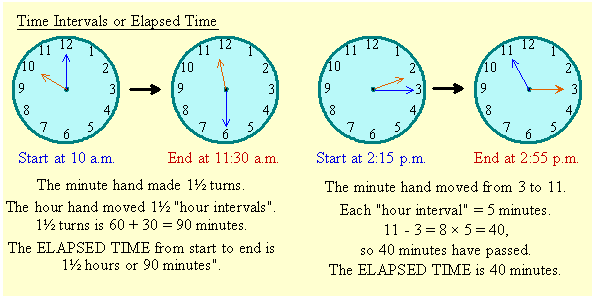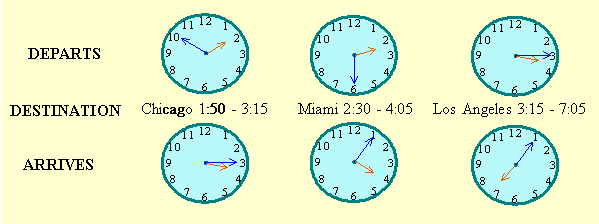
| TELLING TIME - 1 |
What Time is It?

Sundial
Ever since time began, humans have measured it. We needed to know when it would be day or night, winter or summer, when to plant, when to harvest, when to stock up on food to eat during the cold season -- and like all our early measuring systems, we used natural objects and events to measure time. Our first chronometers ( instruments to measure time) were designed to measure the apparent movement of the Sun, Moon, Planets and Stars in the sky.
All this began when the Ancient Babylonians noticed the circular path of the sun in the day sky and divided it into 360 degrees. Each degree was then divided into 60 minutes. Later, once we transfered the approach to the 12 hour clock, and we needed intervals smaller than an hour
(30 degrees), it was divided into 60 minutes each of which was divided into 60 seconds.
The basic units of time measurement are necessarily determined by natural events.
A day is the time it takes the Earth to rotate once on its axis.
An hour is one twenty-fourth of a day.
Days, Hours, Minutes and Seconds are the time intervals we measure on a clock.
| 60 seconds = 1 minute | 60 minutes = 1 hour | 24 hours = 1 day |
Longer time intervals like weeks, months and years are measured on a calendar.
Analog and Digital Clocks

Digital Clock showing time, date, day and temperature.
Today, we see digital clocks everywhere, however that wasn't always so. Up until the invention of transistors, small batteries and quartz chips, the traditional timepiece was an analog clock or wristwatch that operated with interlocking gears and springs known as clockworks (what else?).
If we forgot to wind our watch in the morning, it would stop during the day, then we'd have to reset and wind it so it would keep working. Large grandfather clocks came with a key that we'd insert in a slot in the back of the clock to wind it. These big guys could be wound so that they'd run for a week rather than just a day. Today, most of our analog clocks and watches run on quartz chips like our computers do. Some really big clocks still run on clockworks.
The biggest advantage of an analog clock is that the face displays 12 or 24 hours instead of a single moment in time without reference to elapsed time or time left before you're late, like on a digital clock.
Let's look at and discuss the face of an analog clock. This clock shows hours, minutes and seconds. If you have an appointment at 4 o'clock, this picture should get you to hurry up since you have less than 20 minutes to get to where you're going. On a digital clock you would see the time as 3 : 42, with no "picture" to tell you there isn't much time left.
on this clock face


The second hand circles the clock face every minute or 60 seconds.
The minute hand makes a full turn of the face every hour or 60 minutes.
The hour hand takes 12 hours or half a day to make a full turn.
To get the number of minutes and seconds gone by, we take 5 × the biggest hour number, then add the number of small units -- either minutes or seconds. In this case, we multiply 5 × 8 then add 2 -- that's how we get 42 minutes after 3 o'clock.
.
Is it a.m. or p.m.?
Most of us use a 12 hour clock -- but there are 24 hours in a day -- so we divide it into two 12 hour intervals that begin and end at midnight and noon. To tell them apart, we use the letters a.m. and p.m. -- abbreviations that stand for antemeridian and postmeridian. Meridian means middle -- in this case, middle of the day or noon, the prefix "Ante" means "before" and "post" means "after", so a.m. stands for before noon and p.m. means after noon.
This creates a problem since we don't know which 12 o'clock means noon and which means midnight. The solution to this problem is to use the 24-hour scale like most businesses do. The software that measures time intervals in banks and businesses works best with only numbers rather than a combination of numbers and letters, so more and more, people are telling time on the 24-hour clock.
.
Reading and Writing Time

Note how we use colons ( : ) to separate the hours, minutes and seconds.
Comparing the 1st and 2nd clocks here, we see the hour hand didn't move. The minute hand moved 5 minutes (from 12 to 1) and the second hand moved ¾ of the way round the clock or 45 seconds (¾ of 60). By the 3rd clock, the hour hand moved 1 hour from 2 to 3, the minute hand moved 5 minutes from 1 to 2, and the second hand moved ½ way round the clock or 30 seconds. The time difference between the 2nd and 3rd clocks is 1 hour, 5 minutes and 30 seconds.
Here is how we read or say the times shown here:
a)  ........b)
........b)  .............c)
.............c) 
| a) 10 minutes to (before) 2 o'clock | b) 10 minutes past (after) 10 | c) 22 minutes after 6 o'clock |
We write these times as:
| a) 1: 50 : 56 | b) 10 : 10 : 53 | c) 6 : 22 : 44 |
If we know whether it's morning or afternoon, we add a.m. and p.m. We rarely say or write the seconds value in everyday life, but people who work in radio or TV, pay close attention to the seconds, because every second counts and costs in broadcasting.
Elapsed Time or How Long Has It Been?
When we measure elapsed time, we find how long it has been between the start and the end of some event or happening. If we leave home at 10 a.m. and arrive at Granny's house at 11:30 a.m., our trip took us an hour and a half or 1 hour and 30 minutes. We could also say it took us 90 minutes to get to Granny's house.

To find elapsed time, we count the time gone by
between the start and end of an event.
.
Now get a pencil, an eraser and a note book, copy the questions,
do the practice exercise(s), then check your work with the solutions.
If you get stuck, review the examples in the lesson, then try again.
![]()
Practice Exercise
1) Fill in the blanks:
| a) 7 min = ____ sec | b) 1 hr 10 min = ____ min | c) 79 min = ___ hr ____ min |
| d) 2 days = ____ hrs | e) 120 min = ____ hrs | f) 5 hrs 15 min = ___ min |
2)
a) Write the time shown on each clock in words and in digits: (put in a.m. or p.m.)

3) Find the missing start, end or elapsed time.
| start time | elapsed time | end time | |
| a) | 7: 15 a.m. | 2 hrs 5 min | ? |
| b) | ? | 1 hr 47 min | 7:50 p.m. |
| c) | 10:20 p.m. | ? | 11:30 p.m. |
.
4) Draw clock faces showing the times listed. Use the airline schedule to answer the questions.
| AFTERNOON FLIGHTS FROM ATLANTIC CITY | ||
| Destination | departs at | arrives at |
| Chicago | 1: 50 | 3: 15 |
| Miami | 2: 30 | 4: 05 |
| Los Angeles | 3: 15 | 7:05 |
a) How long is the flying time between Atlantic City and Chicago?
b) How long is the flying time between Atlantic City and Los Angeles?
c) How much longer does it take to fly to Los Angeles than to Miami?
d) How many minutes is this?
![]()
Solutions
1) Fill in the blanks:
| a) 7 min = 7 × 60 = 420 sec |
b) 1 hr 10 min = 60 + 10 = 70 min |
c) 79 min = 60 + 19 = 1 hr 19 min |
| d) 2 days = 2 × 24 = 48 hrs |
e) 120 min = 120 ÷ 60 = 2 hrs |
f) 5 hrs 15 min = 5 × 60 + 15 = 315 min |
2) Write the time shown on each clock in words and in digits: (put in a.m. or p.m.)
| time in words | time in digits |
| a) twelve-thirty p.m. or half past noon | 12: 30 p.m. |
| b) ten minutes to five a.m. or four-fifty a.m. | 4: 50 a.m. |
| c) twenty minutes to two p.m. or one-forty p.m. | 1: 40 p.m. |
3) Find the missing start, end or elapsed time.
| start time | elapsed time | end time |
| 7: 15 a.m. | 2 hrs 5 min | 9:20 a.m. |
| 6:03 p.m. | 1 hr 47 min | 7:50 p.m. |
| 10:20 p.m. | 1 hr 10 min | 11:30 p.m. |
4) Draw clock faces showing the times listed. Use the airline schedule to answer the questions.

a) 3: 15 - 1: 50 = 2: 75 - 1: 50 = 1 hour 25 minutes
b) 7: 05 - 3: 15 = 7: 65 - 3: 15 = 3 hours 50 minutes
c) 3 hours and 50 minutes - 1 hour and 25 minutes = 2 hours and 25 minutes.
d) 2 hours and 25 minutes = 145 minutes
![]()